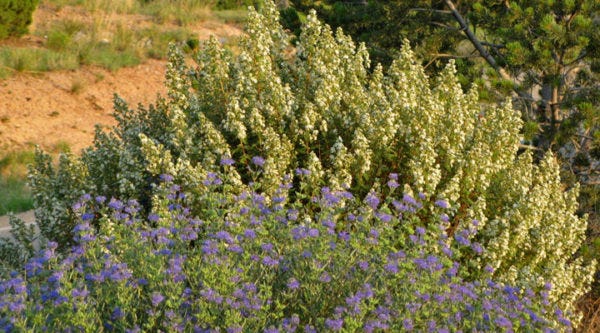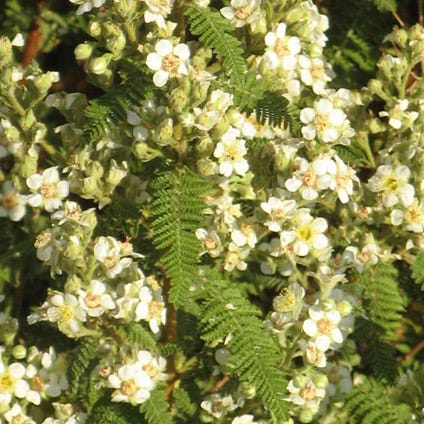Growing Fernbush (Chamaebatiaria millefolium)
by David Salman

Fernbush Is An Exceptional Native Shrub for the Low-Water Garden
I heartily recommend growing Fernbush (Chamaebatiaria millefolium, sometimes also known commonly as Desert Sweet), a native plant worthy of our admiration. It has so many wonderful attributes that make it an essential part of any low-water landscape. It is a naturally tidy-growing woody plant with a soft rounded shape that is beautiful in and out of flower. Many folks who don't know it and see the bush in bloom remark it looks like a "summer lilac." And indeed it does. The voluptuous white flower spikes cover the plant in mid-summer, when most other flowering trees and shrubs have finished blooming months prior.
Native bees, bumblebees, honeybees, moths and butterflies love the nectar-rich flowers. And many beneficial insects are associated with Fernbush. But unlike lilacs that have little to offer after blooming, Fernbush flowers are followed by attractive bronze seed heads that adorn the plants through winter, catching the snow and providing pleasing muted-brown color in the dormant seasons. Small seed-eating birds also feed on its copious seed set in the fall.

Good Looking Leaves: Fernbush Foliage Is Highly Ornamental
Fernbush leaves are highly ornamental, with a pleasing deep olive-green color, and a wonderful smoky, herbal aroma. In many mild to moderate winter climates, the foliage is semi-evergreen. Native to the far western US, Fernbush is found in habitat growing in Nevada and all the five states surrounding Nevada. Normally seen in the foothills and mountain of these 6 western states, I was thrilled to see it growing at over 10,000 ft. elevation near the Methuselah Bristlecone pines in the White Mts. of eastern CA.
Growing Fernbush
This is a tough, durable plant. It is a robust grower all across the western US and Great Plains. It thrives in most soil types and does well when irrigated with drip irrigation systems (not the case for some native shrubs). And it takes no pruning to keep it looking nice and tidy. Just deadhead the old seed heads in early spring.Companion Plants for Fernbush
Fernbush combines so readily with other shrubs, especially Old World summer bloomers like Blue Mist Spirea (Caryopteris), Russian Sage (Perovskia) and Butterfly Bush (Buddleia). Native shrubs that make a neighbors include Apache Plume (Fallugia) and selections like 'Three-Leaf' Sumac (Rhus trilobata) and Pawnee Buttes® Sand Cherry. Groundcover-type shrubs, such as Sand Cherry, are best planted in front of Fernbush to grow a beautiful "skirt" that spreads out from around its base.
And don't forget planting Chamaebatiaria with tall growing ornamental grasses. 'Pink Flamingo' Muhly grass (Muhlenbergia) and 'Windbreaker' Giant Sacaton grass (Sporobolus) are used behind and to the side, while 'Blonde Ambition' Blue Grama looks fabulous in front.
Fall Planting is Ideal
Fernbush is very cold hardy and gets a good jump on next growing season by planting it in the fall. This establishes its root system and lets it grow larger the first year than the same size plant planted in spring.
© All articles are copyrighted by High Country Gardens. Republishing an entire High Country Gardens blog post or article is prohibited without written permission. Please feel free to share a short excerpt with a link back to the article on social media websites, such as Facebook, Twitter and Pinterest.